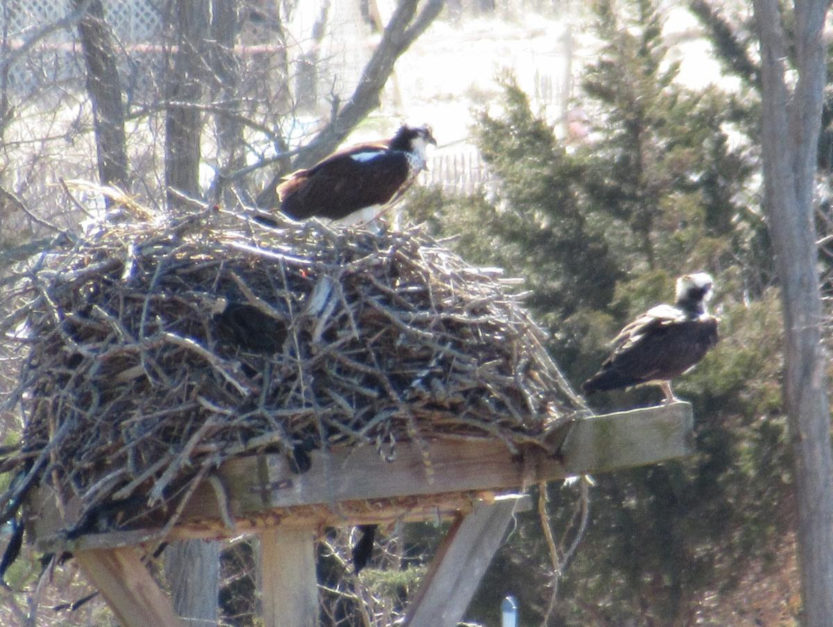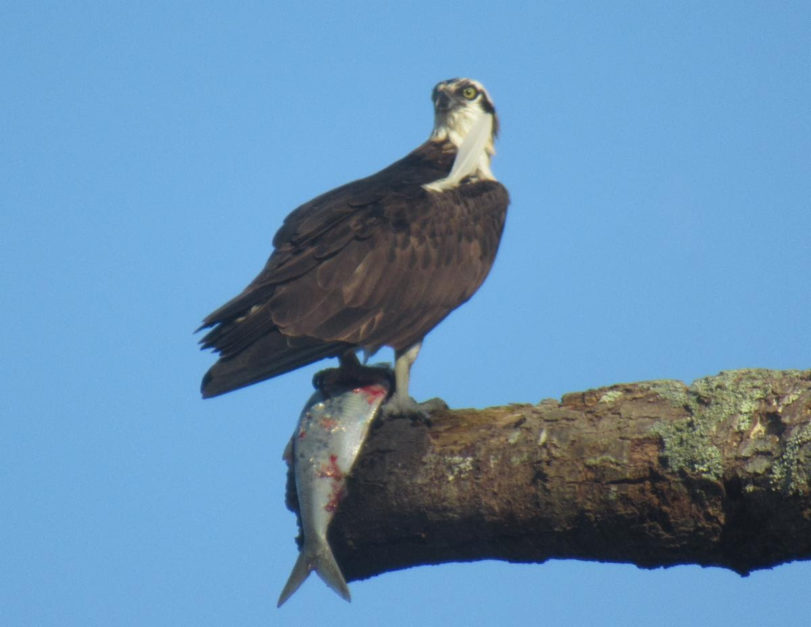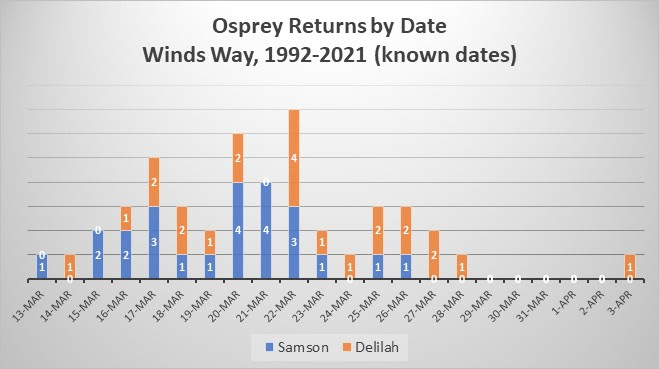
A Bird’s View from Winds Way | Osprey
Revisited
—————
a monthly column by Nancy Gilbert
~~~~~~~~~~~~~~~~~~

——————
The last time I wrote about Osprey was late July of 2020. It was drizzling. I described two young Osprey perched on the edge of the nest sharing a fish, with the mother and a third baby sitting in the oak tree outside our kitchen window, each working on their own fish. And I confessed to anthropomorphizing these remarkable birds by naming them. Last year’s young were Dignity, Respect and Freedom. The parents are Samson and Delilah, names we assigned to the returning male and female Osprey we’ve been tracking for 30 years. Naming probably does not benefit wildlife management and conservation in general as it emphasizes the individual more than the species, but it can also result in a feeling of connection. It is both a good and bad attribute that we save what we love. Therefore, it is critical to remember that all lives on earth are in our hands and to take this responsibility seriously. All species rely on a reputation they don’t know they have. It is up to us to understand the role each creature plays and to protect and fight for biodiversity.
——————
Back to Samson and Delilah. We’ve been anxiously watching the nest for several days. According to our calculations Delilah should be incubating her first egg by now. Osprey lay their eggs asynchronously with three being the usual number. Raising a brood of three means that Samson will have to supply about six pounds of fish a day, while Delilah will spend about 40 days with occasional short breaks by Samson, sitting on the eggs. And as often happens, not every hatchling will survive. Sometimes this is due to a scarcity of fish. Once we watched a member of a brood of two push its sibling out of the nest. We carried a ladder into the wetlands, propped it precariously against the nest pole, and on the advice of the renowned naturalist Paul Stoutenburgh, wrapped the young bird in a towel and delivered it back to the nest. This was the bird’s only chance for survival as Osprey, especially when young, do not fare well in captivity. Sadly, the stronger sibling viciously attacked the bird we so carefully returned. Where were the parents? In a nearby tree, watching. They did not intervene. Their goal is survival of the species, which means feeding and protecting the oldest and strongest of the hatchlings, not protecting and providing for all of them. This experience was an important if painful lesson in the dangers of attributing human characteristics to wild creatures.
——————
I just looked through the scope again, hoping to report that Delilah now has an egg! It’s raining hard, and she is sitting on the southernmost edge of the nest, facing into the wind. You can tell when the incubation begins because she settles down into the nest and all you can see is the top of her head. In the last week both birds have brought bits of dried grass and some black plastic to use as lining. They take turns belly flopping into the center and scrunching around to make sure the fit is right. Despite the enormous size of the nest, they continue to add branches every year. One of my big fears is that the whole edifice will topple in a nor’easter.
——————

——————
The wonderful northward progression of songbirds, warblers, hummingbirds and shore birds is beginning, but what always announces spring to me is the return of the Osprey. This year Samson and Delilah arrived at Winds Way 10 days later than usual. While it is easy to tell the male from the female (note the necklace of dark feathers sported by Delilah, the bird on the left in the photo at the top), it is impossible to know if this pair is the same one we watched so closely last year. We expect that over the years there have been several Delilahs and several Samsons. Below is a chart summarizing return dates to the North Fork. Above, that’s Samson sitting on an oak outside our kitchen eating a Menhaden (aka Bunker) on March 26th, his first day back.
~~~~~~~~~~~~~~~~~~~~~~~~~~~~~

1992 and 2021. Some years we were not here for their arrival, so data is incomplete. Samson’s earliest arrival was March 13, his average arrival date is March 19, Delilah’s average arrival date is March 22. This year he arrived on March 26, his latest ever in our records. She arrived the following day, her third latest. Samson generally arrives about three days before Delilah, although three times she arrived first. Of course, we are not sure it has always been the same Samson and Delilah.
——————
We have 18 years of data tracking when the first egg was laid – on average 17 days after the arrival of the second bird, but quite variable with the longest time being 21 days after the second arrival. On average, Delilah and Samson have incubated their eggs for 39 days before the first hatchling appeared. The oldest chick fledges 56 days after that. We predict that tentative first flight of the first hatchling will be July 17 this year.
~~~~~~~~~~~~~~~~~~~~~~~~~~~~~
One of the joys of living where we do is watching small groups of Osprey flying overhead. Sometimes it looks as if it might be Samson chasing off a would-be competitor; other times it looks as if they are just having fun participating in what we’ve dubbed the Osprey Soaring Club. I often wonder if the young from several years ago come back to say hello. Last year’s young will remain in their wintering grounds as far south as Central America, the Caribbean, or South America. They won’t return north to breed until next year. About a week ago while cleaning up a garden I was lucky enough to witness two Ospreys chasing a Bald Eagle! I was stunned at the size difference – an adult Bald Eagle has a wingspan from almost 6 feet to 7.5 feet. That of an Osprey is 5 feet. And of course there is nothing more thrilling than a male’s aerial sky-dance. This is a ritual of breeding season and the dancer is often clasping nesting material or a fish in his talons. He alternates hovering with slow, shallow swoops high above the nest, all the while uttering repeated screaming calls as he descends toward the nest.
——————
Happily, Ospreys are a conservation success story. Their precipitous decline was halted by pesticide bans and the construction of artificial nest sites. From the early 1950s to 1970s, 90% of the breeding pairs between New York City and Boston disappeared. Ospreys still face habitat loss, being shot in their wintering grounds, and the dangers of violent storms while migrating. How lucky we are to share the world with them! But we must also continue to protect them, and make sure our waterways contain an abundant supply of healthy fish. I wish you many sightings this spring and summer. Keep your fingers crossed that Delilah’s first egg arrives soon.
——————
A Bird’s View from Winds Way is a monthly column by one of our board members and avid birder, Nancy Gilbert — with photos from her husband Richard Wines — on our local birds. Nancy’s columns appear on our blog, so please tune in each month for more from Winds Way.
————————

————
=============================================

AAQ / Resource: McDonough & Conroy Architects
________________________________________________
